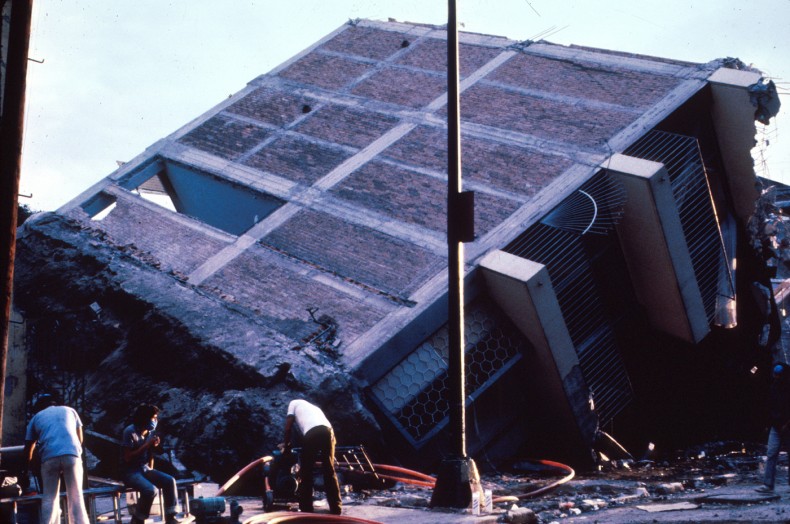 Last Saturday morning at 2:36 AM, Central Time, I woke up to the sound of my house creaking. For a split second I thought I might still be tipsy from the long night out in the La Condesa neighborhood of Mexico City, where I live. But that wasn’t it.
Last Saturday morning at 2:36 AM, Central Time, I woke up to the sound of my house creaking. For a split second I thought I might still be tipsy from the long night out in the La Condesa neighborhood of Mexico City, where I live. But that wasn’t it.
“Earthquake!” I yelled and hit the floor next to the bed while my wife made for the door frame.
Which, oddly enough, got me in trouble. You see, when it comes to surviving an earthquake I was following the supposed “triangle of life” principle (pictured below) while my wife opted for “hide in a doorway” approach. She was calling to me in a panic to join her in the doorway, but I refused for two reasons. First, it’s never safe to go wandering about during an earthquake once you’ve chosen your spot. But second, I knew I was right. I chose the right place.
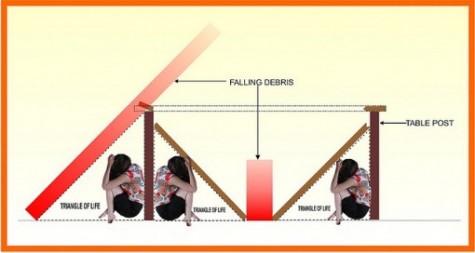
It’s the third moderate quake in three weeks. Most people might find all this shaking unsettling, but not me. As a Northern Californian, I am a veteran of several big earthquakes, including the massive 1989 Loma Prieta quake. And as an expert, I can tell you the doorjam thing is a total myth. It’s all about the triangle of life.
Eventually the room stopped shaking, and a discussion ensued about abandoning one’s spouse. The general consensus in the end was that I am a jerk. That may be – but I swear I’m not wrong.
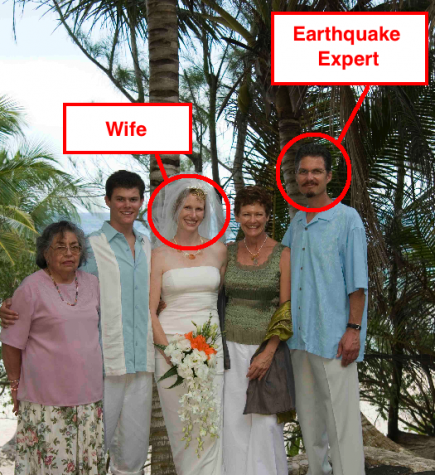 So I decided to call an expert. Mason Walters is a senior engineer at Forrell Engineering and one of the minds behind UC Berkeley’s amazing new stadium (the original being cleverly built right on the Hayward Fault). But he’s more than that, he’s a true earthquake geek. His office is littered with Slinkies and little ball bearings that he uses to demonstrate various earthquake forces. He makes lists of buildings on the Berkeley campus that loved ones are forbidden to enter (Tolman Hall, I’m looking at you). And in his spare time he’s also my father-in-law.
So I decided to call an expert. Mason Walters is a senior engineer at Forrell Engineering and one of the minds behind UC Berkeley’s amazing new stadium (the original being cleverly built right on the Hayward Fault). But he’s more than that, he’s a true earthquake geek. His office is littered with Slinkies and little ball bearings that he uses to demonstrate various earthquake forces. He makes lists of buildings on the Berkeley campus that loved ones are forbidden to enter (Tolman Hall, I’m looking at you). And in his spare time he’s also my father-in-law.
It turns out he’s also fascinated with Mexico City earthquakes. You see, quakes here are unique in the world because we don’t actually feel the quake itself as much as the distant echo of it, magnified through soil. As such, it’s more gradual, like brandy swirled in a sniffer. If Mexico City is a martini, it’s stirred, not shaken.
This creates all manner of strange physics. Buildings of the right height turn into giant tuning forks, magnifying the earthquake. Everything sways in nearly the same way. And for a guy like Mason, it’s about the coolest place on Earth to think about engineering (when he visited, all he wanted to see was this building, Mexico’s safest and possibly ugliest skyscraper).
So who was right? Where’s the best spot in our house to go if a really big quake hits? Should you run for the door or the triangle of life?
“Neither one of you are exactly wrong or right,” he says. “You won’t really have a choice. You will be on your ass. Let’s say you’re in bed. You may get thrown out of bed but you’re not going to be able to stand up and navigate around.”
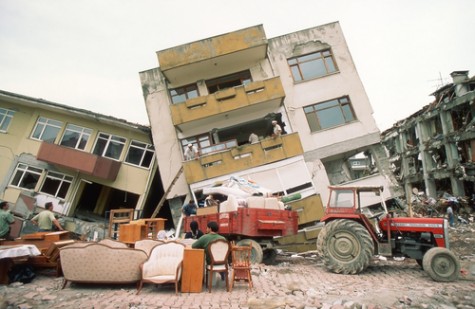
Okay, so the triangle of life is kinda true but it mostly applies to cheap buildings in the developing world, where all manner of stuff – like the floor above – may come down on you. At that point, you are already daring the fates. Even then, though, it’s highly debatable if it works. And yes, the whole doorframe thing is a myth. Collapsed buildings don’t still have doorframes.
But these are really the wrong questions. It turns out that if you haven’t taken a few steps already, where you hide is basically rearranging deck chairs on the Titanic. According to Mason, there are two kinds of earthquakes in the modern world. One is the kind that allows you to run to your favorite hiding spot, under the pool table in the den. But if you can do that, it’s not big enough to do any real damage anyway. The second is big enough to do real damage, but in that case you can’t do more than crawl under the bed.
“It’s going to have vertical acceleration as well as horizontal. I’m telling you, you can’t imagine it until you’ve been there. This is so disorienting that there’s just very few options in terms of moving to some premeditated place,” he says (though, thanks to its odd physics, Mexico City is exempted from the up/down movement).
Yet I remember distinctly running to a doorframe during the 1989 Bay Area quake. The ground was moving but it wasn’t impossible to walk. Well, it seems that by the time the quake hit me, it had mostly petered out. In fact I’m not as badass as I thought – I’ve never felt a truly scary quake.
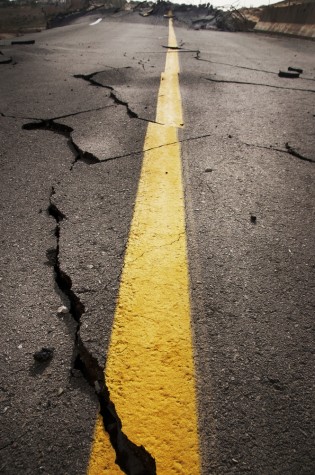 Scary earthquakes in most parts of the world can generate as much one G of acceleration. Imagine standing on a bus without a bar or a strap and imagine it comes to a sudden stop. That’s a slice of what you would feel. Except it would be going in both directions, plus up and down (“galloping” is the word Mason uses). So I suppose … imagine a giant picks up the bus and rattles it around to hear what’s inside.
Scary earthquakes in most parts of the world can generate as much one G of acceleration. Imagine standing on a bus without a bar or a strap and imagine it comes to a sudden stop. That’s a slice of what you would feel. Except it would be going in both directions, plus up and down (“galloping” is the word Mason uses). So I suppose … imagine a giant picks up the bus and rattles it around to hear what’s inside.
Here in Mexico City, they can still be damaging, but not the same way. Imagine the giant swills the bus around like a fine wine for a really long time.
So what’s the lesson here? Your best strategy is to duck, cover, and kiss your ass goodbye? Shockingly, the answer may be yes. Minus the last part. It may just be better to duck and pray. But by then your work should be done. You should have checked that you don’t live in a building with bad, unreinforced masonry. You should have secured your bookcases and the 200-lb wall-mounted modern art installation. Earthquake survival is about being prepared, not being clever in the moment.
Thankfully, American engineering in cities near faults is extraordinarily good. As is Mexico City’s. Almost all the buildings here have been tested in quake after quake. In fact it’s one of the better-studied earthquake cities in the world. For instance, we know that buildings between 8 and 20 stories are uniquely dangerous here. We know that in any other earthquake city, my squat century-old brick building would be a death trap. But here, the slower shaking makes it the perfect place to ride out a temblor.
But in many US cities, people don’t even know the danger they’re in. If you live in an older building in Portland, Seattle, or Charleston, you have powerful faults nearby and potentially spotty construction. A fault runs under St Louis that once shook so hard it rang the bells in Boston and diverted the frigging Mississippi River. And yet many buildings there seem to ignore this fact. When the big one hits in these cities, it would be best to avoid any neighborhoods that contain the words “charming” or “historic.”
So bolt anything dangerous to the walls. Think about replacing the lead chandelier. Find out what your building is made of (wood frames are usually pretty good). And when it hits, just try to get under something and cover your head. If you’re not getting tossed like a rag doll, don’t worry, you’ll be fine. Enjoy the ride.
 “If your earthquake is not strong enough to knock you on your ass and you have the choice of getting to a doorway, it means the earthquake’s not strong enough to really worry about,” Mason says. “So just enjoy the novelty of it. Watch things move around.”
“If your earthquake is not strong enough to knock you on your ass and you have the choice of getting to a doorway, it means the earthquake’s not strong enough to really worry about,” Mason says. “So just enjoy the novelty of it. Watch things move around.”
Photo Credit: Shutterstock, among others
I had just gotten my apt in Col. Roma Norte. I went to Starbucks the morning of Good Friday, April 18, 2014 when that earthquake hit. I did what the others did, ran outside into the street! Friends told me I should have gotten under a table! Am now in Dallas packing to move to Col. Roma when another earthquake hits Mexico City. Friends wrote me, aren’t you SCARED to move? and I said, not really as I type you this message hiding in the closet because the TORNADO Sirens are going off! Every place has their thang I would say. Good post.
Great piece. As a San Francisco native, I’m hard-wired not to place glass items very high up and not to leave liquids by electronics when I leave a room. However, I am undeniably oblivious to thinking of sweet spots to hide, prepping water and nonperishable foods, or escape plans.
Although quakes have influenced little quirks in my behavior, I’ve actually never consciously felt one. It’s insanely comforting to know that either I’m fucked or it’s nothing to worry about, odds in favor of the latter. It also affirms my decision not to opt for earthquake insurance- suckas!
Even more importantly, the visual of a giant drinking wine then rattling a bus is forever engrained in my brain and associated with earthquakes. So I’ll likely be giggling at the mention of earthquakes henceforth. Score!
The experts behind the ShakeOut drills strongly advise against the “triangle of life” approach:
http://earthquakecountry.org/dropcoverholdon/#notrecommended
The conversation you described after the quake was over cracked me up! It’s of course funny now that you were able to write about it. It’s comforting to think that you will be swilled around like a glass of wine, even though I would most likely throw up (prone to motion sickness). It beats being blended in a Vitamix. Happy Nesting!